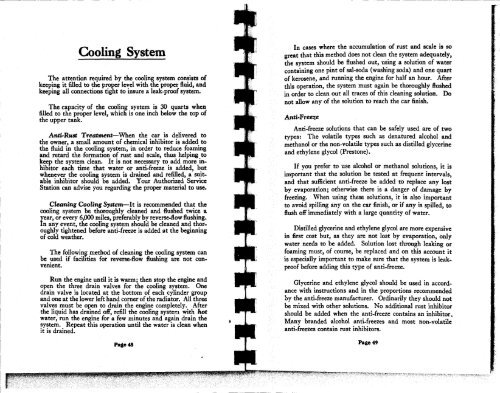1938 Cadillac V16 - GM Heritage Center
1938 Cadillac V16 - GM Heritage Center
1938 Cadillac V16 - GM Heritage Center
You also want an ePaper? Increase the reach of your titles
YUMPU automatically turns print PDFs into web optimized ePapers that Google loves.
Cooling System<br />
The attention required by the cooling system consists of<br />
keeping it filled to the proper level with the proper fluid, and<br />
keeping all connections tight to insure a leak-proof system.<br />
The capacity of the cooling system is 30 quarts when<br />
filled to the proper level, which is one inch below the top of<br />
the upper tank.<br />
Anti-Rust Treatment—When the car is delivered to<br />
the owner, a small amount of chemical inhibitor is added to<br />
the fluid in the cooling system, in order to reduce foaming<br />
and retard the formation of rust and scale, thus helping to<br />
keep the system clean. It is not necessary to add more inhibitor<br />
each time that water or anti-freeze is added, but<br />
whenever the cooling system is drained and refilled, a suitable<br />
inhibitor should be added. Your Authorized Service<br />
Station can advise you regarding the proper material to use.<br />
Cleaning Cooling System—It is recommended that the<br />
cooling system be thoroughly cleaned and flushed twice a<br />
year, or every 6,000 miles, preferably by reverse-flow flushing.<br />
In any event, the cooling system should be cleaned and thoroughly<br />
tightened before anti-freeze is added at the beginning<br />
of cold weather.<br />
The following method of cleaning the cooling system can<br />
be used if facilities for reverse-flow flushing are not convenient.<br />
Run the engine until it is warm; then stop the engine and<br />
open the three drain valves for the cooling system. One<br />
drain valve is located at the bottom of each cylinder group<br />
and one at the lower left hand corner of the radiator. All three<br />
valves must be open to drain the engine completely. After<br />
the liquid has drained off, refill the cooling system with hot<br />
water, run the engine for a few minutes and again drain the<br />
system. Repeat this operation until the water is clean when<br />
it is drained.<br />
Page 48<br />
In cases where the accumulation of rust and scale is so<br />
great that this method does not clean the system adequately,<br />
the system should be flushed out, using a solution of water<br />
containing one pint of sal-soda (washing soda) and one quart<br />
of kerosene, and running the engine for half an hour. After<br />
this operation, the system must again be thoroughly flushed<br />
in order to clean out all traces of this cleaning solution. Do<br />
not allow any of the solution to reach the car finish.<br />
Anti'Freeze<br />
Anti-freeze solutions that can be safely used are of two<br />
types: The volatile types such as denatured alcohol and<br />
methanol or the non-volatile types such as distilled glycerine<br />
and ethylene glycol (Prestone).<br />
If you prefer to use alcohol or methanol solutions, it is<br />
important that the solution be tested at frequent intervals,<br />
and that sufficient anti-freeze be added to replace any lost<br />
by evaporation; otherwise there is a danger of damage by<br />
freezing. When using these solutions, it is also important<br />
to avoid spilling any on the car finish, or if any is spilled, to<br />
flush off immediately with a large quantity of water.<br />
Distilled glycerine and ethylene glycol are more expensive<br />
in first cost but, as they are not lost by evaporation, only<br />
water needs to be added. Solution lost through leaking or<br />
foaming must, of course, be replaced and on this account it<br />
is especially important to make sure that the system is leakproof<br />
before adding this type of anti-freeze.<br />
Glycerine and ethylene glycol should be used in accordance<br />
with instructions and in the proportions recommended<br />
by the anti-freeze manufacturer. Ordinarily they should not<br />
be mixed with other solutions. No additional rust inhibitor<br />
should be added when the anti-freeze contains an inhibitor.<br />
Many branded alcohol anti-freezes and most non-volatile<br />
anti-freezes contain rust inhibitors.<br />
Page 49
















